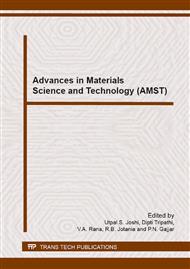p.18
p.23
p.27
p.31
p.35
p.39
p.44
p.48
p.52
Nano-MRF: A Material for Damping Application
Abstract:
A magnetorheological fluid (MR), a suspension of micron-sized magnetic particles in a carrier fluid, has vast applications in the field of vibration dampers, seismic vibration dampers, shock absorbers, clutches, break system, vehicle suspensions, seat suspensions, Robotics, design of buildings and bridges etc. The biggest issue in MR fluid is the settling of particles under gravity. To overcome this, one of the approaches is to mix micron size particles in a magnetic fluid (MF) known as Nano-MRF. In the present paper, we report a technique to synthesis Nano-MRF suspension having high stability under gravitation as well as magnetic field. X-ray diffraction (XRD) and dynamic light scattering are used to characterize the solid/liquid system. Magnetic and Magnetorheological properties are studied and results indicate that: instead of decreasing stress with increasing temperature we have observed an increase until 40°C and thereafter, it decreases. This is explained based on, inter and intra particles/chain interaction as well as synergetic effect between small and large sized magnetic dispersion.
Info:
Periodical:
Pages:
35-38
Citation:
Online since:
November 2013
Authors:
Price:
Сopyright:
© 2014 Trans Tech Publications Ltd. All Rights Reserved
Share:
Citation:


